
Things Circle Makers Definitely Don’t Use In The Field
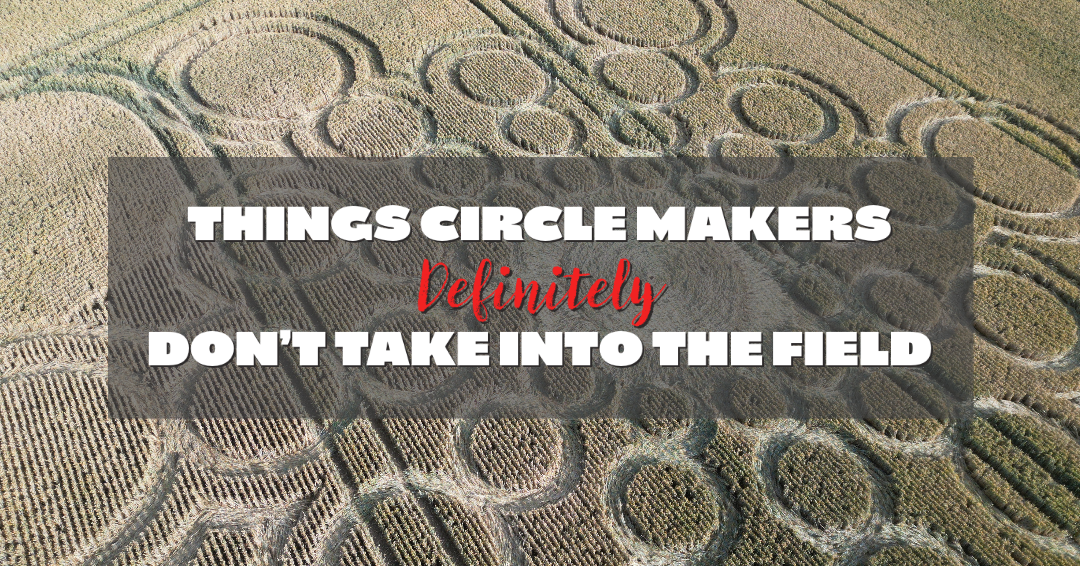
INTRODUCTION
Croppiedom is awash with circle making experts, the overwhelming majority of whom are even less qualified to talk on the matter than your average, fat, guitar teacher from Bournemouth who once slithered his way around half the circumference of a small circle with a plank on a rope. Nonetheless, we continue to be amazed by the insight these people offer as to the ins and outs of the circle construction process, especially when they’re completely wide of the mark. The Croppie spoke to a circle maker to get the low down on the things they definitely don’t utilise in the field.
ALCOHOL & DRUGS

The use of alcohol and drugs in the field can only end one way… Photograph by Jurassic Drone
Let’s start in the hours before we go into make a crop circle. Some people say circle makers are drunks or druggies but no modern circle maker with any pride would go into the field whilst under the influence. We are better than that. I’ve seen what happens when someone irresponsible turns up after a day at the bottom of a bottle or fifteen. The results usually aren’t what you’d want. Just look at some of the rubbish made in Somerset and Dorset over the past five years.
STRING

Pull tight on that string, son. Oh, damn… Photograph by Nick Bull
People are always talking about us using ‘planks and string’. I get the former, but not the string. I’ve used it just once in more than a decade and that was as an experiment to mark out the perimeter of a geometric shape. It was fiddly and served a purpose whilst short of manpower. Otherwise, what’s the purpose of the string? As a rein for a stomper? We use rope. To pull tight and scribe a circle? We use surveying tape for that as it’s stronger, less likely to snap and has measurements printed onto it.
LAWNMOWERS & STRIMMERS

The Mowing Devil hard at work.
I guess the last covert circle maker to cut the crop was the devil in 1678. Plants in crop circles these days are bent over rather than sliced. The only other example of cutting in anything resembling a crop circle was in the 1990s. An American croppie [Jon-Erik Beckjord] used a strimmer to write a message to aliens in a Wiltshire field. I think it read ‘talk to us’.
LADDERS

It’s a ladder about to be taken into a field … as seen at the 1992 crop circle making competition!
I read an article in The Guardian in 2022 where a Dorset farmer was explaining that crop circle makers use ladders in their work. It’s something I’ve heard a few times through the years. I think it has something to do with media coverage of a crop circle making competition that was held in 1992 [which you can see here]. If I recall correctly, I read that one team was using a step ladder and bar stools to help them get above the standing crop. [Yes, this was the case, as the photograph below illustrates]
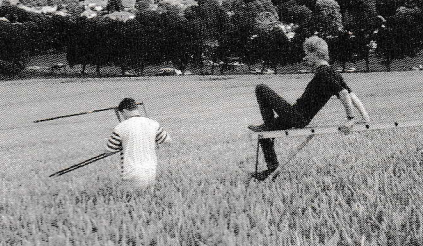
Adrian Dexter and his team from Westland in Yeovil using a ladder to help in the construction of their crop circle. Their effort won the 1992 Crop Circle Making Competition. Photograph by Jurgen Kronig.
Whilst it may have been useful to use ladders in a competition, there’s no way any modern circle makers are going to be hauling ladders around in the dead of night.
MICROWAVES
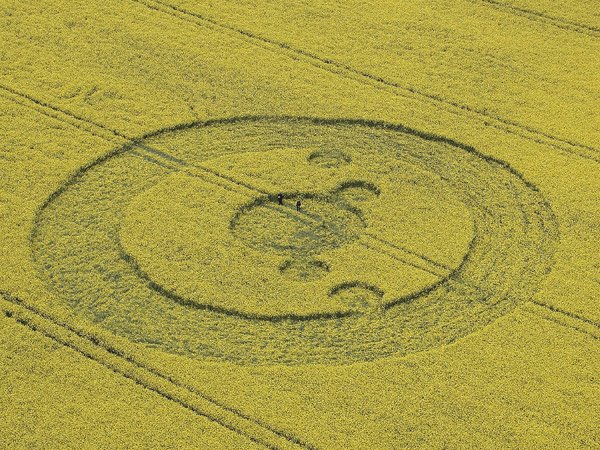
Microwaves clearly melted the brain of the creator of this mess. Or was it the nine pints consumed beforehand? Photograph by Charlie Summers.
I’ve seen it said that circle makers heat plants to flatten them, using the magnetron from a microwave. Of course we do. We also use soundwaves from modified amplifiers that only emit ultrasonic frequencies. I’m laughing, but I can understand where the microwave idea comes from. [Supposed biophysicist William Levengood suggested the plants in a circle were heated at the nodal points and laid down.]
HEAD-TORCHES

Julian Richardson with a headtorch working on a commission for Audi. Photo by Audi.
I recently heard a podcast where [researcher] Gary King was saying crop circle makers stand out in the darkness as we supposedly use head-torches. This staggered me. The only time I’ve seen images of circle makers sporting head-torches are those that involve paid advertising jobs. It just doesn’t happen in a real, covert circle making environment. You don’t want to be seen so you’re hardly going to wear something that just draws attention to yourself.
Doug and Dave never wore head-torches, so why would we? Should you need an artificial light source to check a plan, you can simply crouch down against the crop with the display of a smart-watch on minimum brightness.
GARDEN ROLLERS

The beautiful 1992 charm bracelet. Disappointingly, it was claimed by Jim Schnabel in his book ‘Round In Circles’ but it stands as a good insight into what can be made with a garden roller.
Let’s get this straight. Some circle makers did use garden rollers, including old schoolers Jim Schnabel and Rob Irving. It’s not something you hear of anymore, though.
Those garden rollers I’ve seen are bulky and utilise a cylinder that is either made of heavy concrete or needs to be filled with water. Neither is practical when you’re trying to get over a fence or through a narrow gap alongside a locked gate. A stomper [a plank with a rope rein] is much easier to carry.
DRONES

If only someone had put their drone up in the middle of the night…
I guess the idea is you send your DJI up above your heads to make sure your crop circle is going okay. It’s not going to work at night, though, is it? You’ll end up with a black scene. I don’t see any circle maker spending the money to modify their drones to night vision. Anyhow, if you’ve faith in your own ability I really don’t see the need for such a superfluous piece of kit.
NIGHT VISION GOGGLES

Imagine having these strapped to your face all night…
I’ve read that crop circle makers don’t get caught because they wear night vision goggles. I’ve seen them taken into a field once and all they did was provide ten minutes of uneasiness as every deer and fox in the area suddenly become visible. Anyhow, the goggles are simply too bulky, disorientating and uncomfortable to be worn for any real length of time whilst making a crop circle. Besides, how am I also going to wear my head-torch?
You really don’t need any night vision gear as after an hour or so in the field your eyesight becomes good enough to spot anyone who might potentially stumble across you.
GPS

This is what GPS does to a crop circle. It ends up all wonky.
Someone put it to me that we use GPS enabled mapping software to help mark out specific points in a formation. From my own experience of animal trackers, your consumer level GPS is only accurate to a metre or two. That might not sound like much of a problem, but in a design that is between 60 and 100m in diameter, that’s a significant distance. It’s certainly enough to add enough wonk factor to make it look like your circle was put down by the professionals in Dorset.



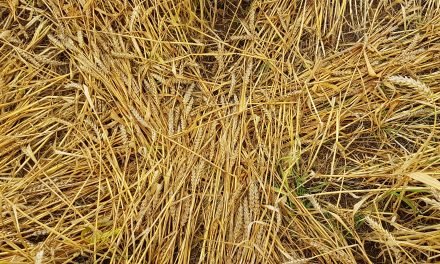
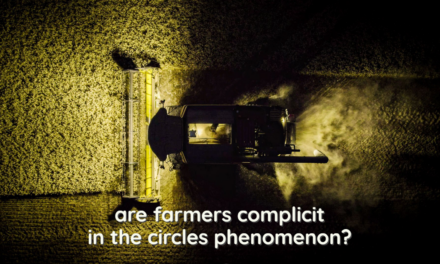
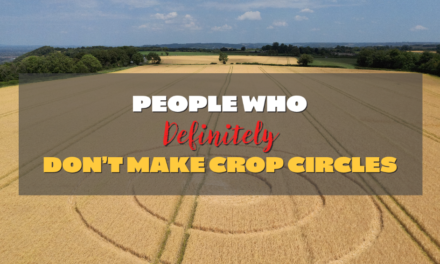
Looks like you’ve upset some people on facey with this one.
There seems to be some confusion at their end. Hardly surprising when the community brain cell is on annual leave.